Statistics: Confirmatory and Exploratory Analysis
VerifiedAdded on 2023/01/13
|9
|1486
|41
AI Summary
This document provides a brief report on confirmatory and exploratory analysis in statistics. It includes descriptive statistics, correlation test results, scatter plot, independent t-test results, and a discussion on the implications of statistical significance on the replication crisis in psychology.
Contribute Materials
Your contribution can guide someone’s learning journey. Share your
documents today.
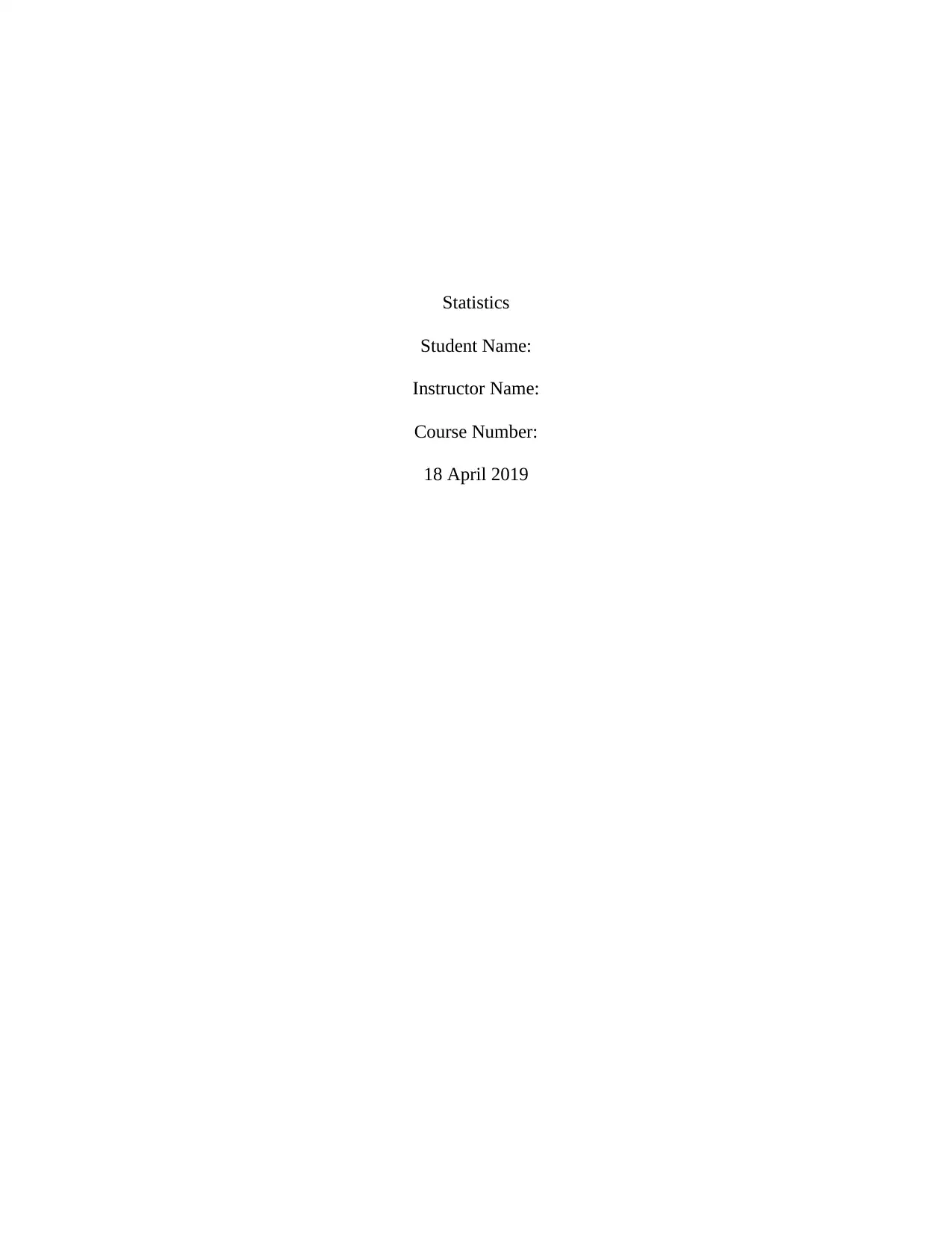
Statistics
Student Name:
Instructor Name:
Course Number:
18 April 2019
Student Name:
Instructor Name:
Course Number:
18 April 2019
Secure Best Marks with AI Grader
Need help grading? Try our AI Grader for instant feedback on your assignments.
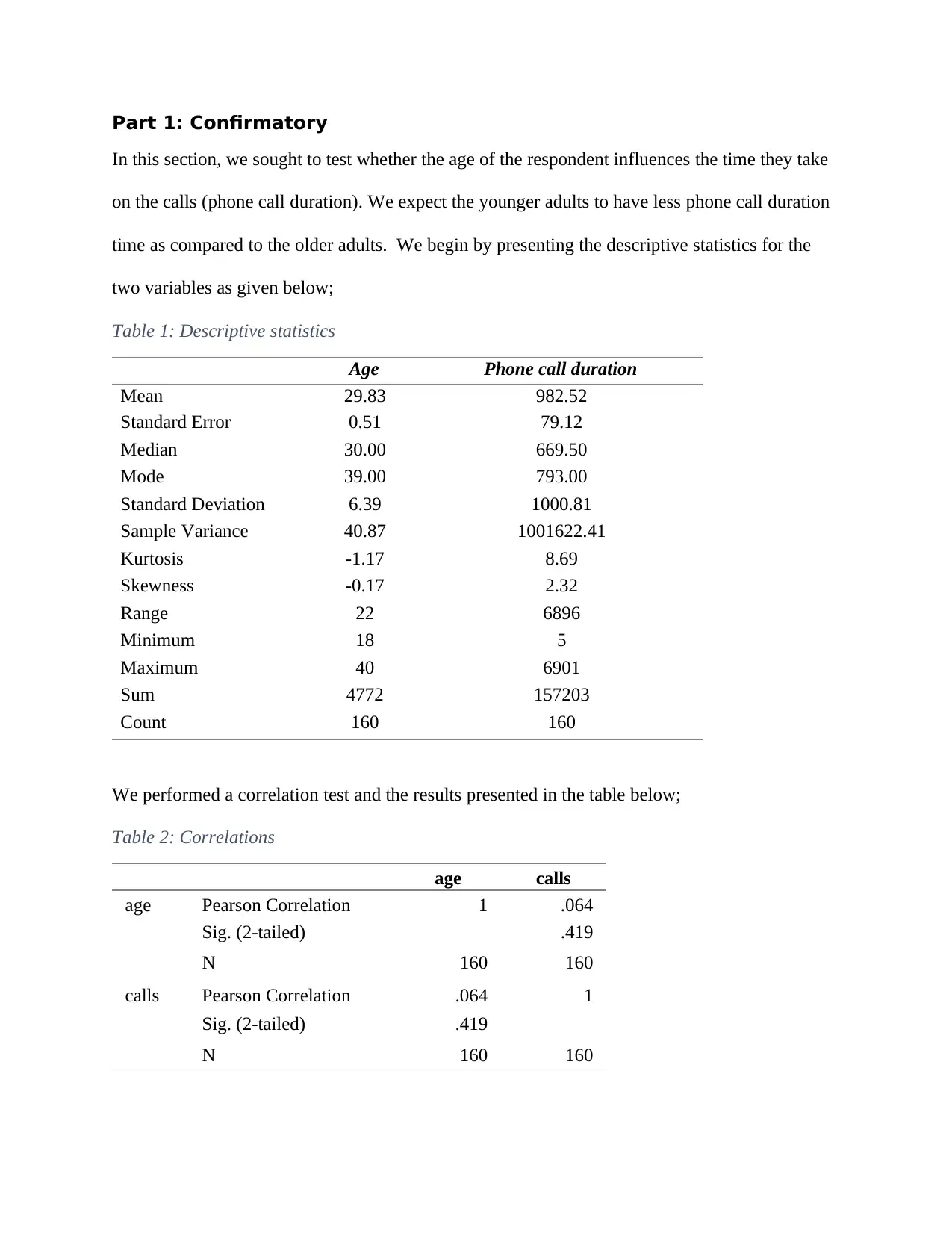
Part 1: Confirmatory
In this section, we sought to test whether the age of the respondent influences the time they take
on the calls (phone call duration). We expect the younger adults to have less phone call duration
time as compared to the older adults. We begin by presenting the descriptive statistics for the
two variables as given below;
Table 1: Descriptive statistics
Age Phone call duration
Mean 29.83 982.52
Standard Error 0.51 79.12
Median 30.00 669.50
Mode 39.00 793.00
Standard Deviation 6.39 1000.81
Sample Variance 40.87 1001622.41
Kurtosis -1.17 8.69
Skewness -0.17 2.32
Range 22 6896
Minimum 18 5
Maximum 40 6901
Sum 4772 157203
Count 160 160
We performed a correlation test and the results presented in the table below;
Table 2: Correlations
age calls
age Pearson Correlation 1 .064
Sig. (2-tailed) .419
N 160 160
calls Pearson Correlation .064 1
Sig. (2-tailed) .419
N 160 160
In this section, we sought to test whether the age of the respondent influences the time they take
on the calls (phone call duration). We expect the younger adults to have less phone call duration
time as compared to the older adults. We begin by presenting the descriptive statistics for the
two variables as given below;
Table 1: Descriptive statistics
Age Phone call duration
Mean 29.83 982.52
Standard Error 0.51 79.12
Median 30.00 669.50
Mode 39.00 793.00
Standard Deviation 6.39 1000.81
Sample Variance 40.87 1001622.41
Kurtosis -1.17 8.69
Skewness -0.17 2.32
Range 22 6896
Minimum 18 5
Maximum 40 6901
Sum 4772 157203
Count 160 160
We performed a correlation test and the results presented in the table below;
Table 2: Correlations
age calls
age Pearson Correlation 1 .064
Sig. (2-tailed) .419
N 160 160
calls Pearson Correlation .064 1
Sig. (2-tailed) .419
N 160 160
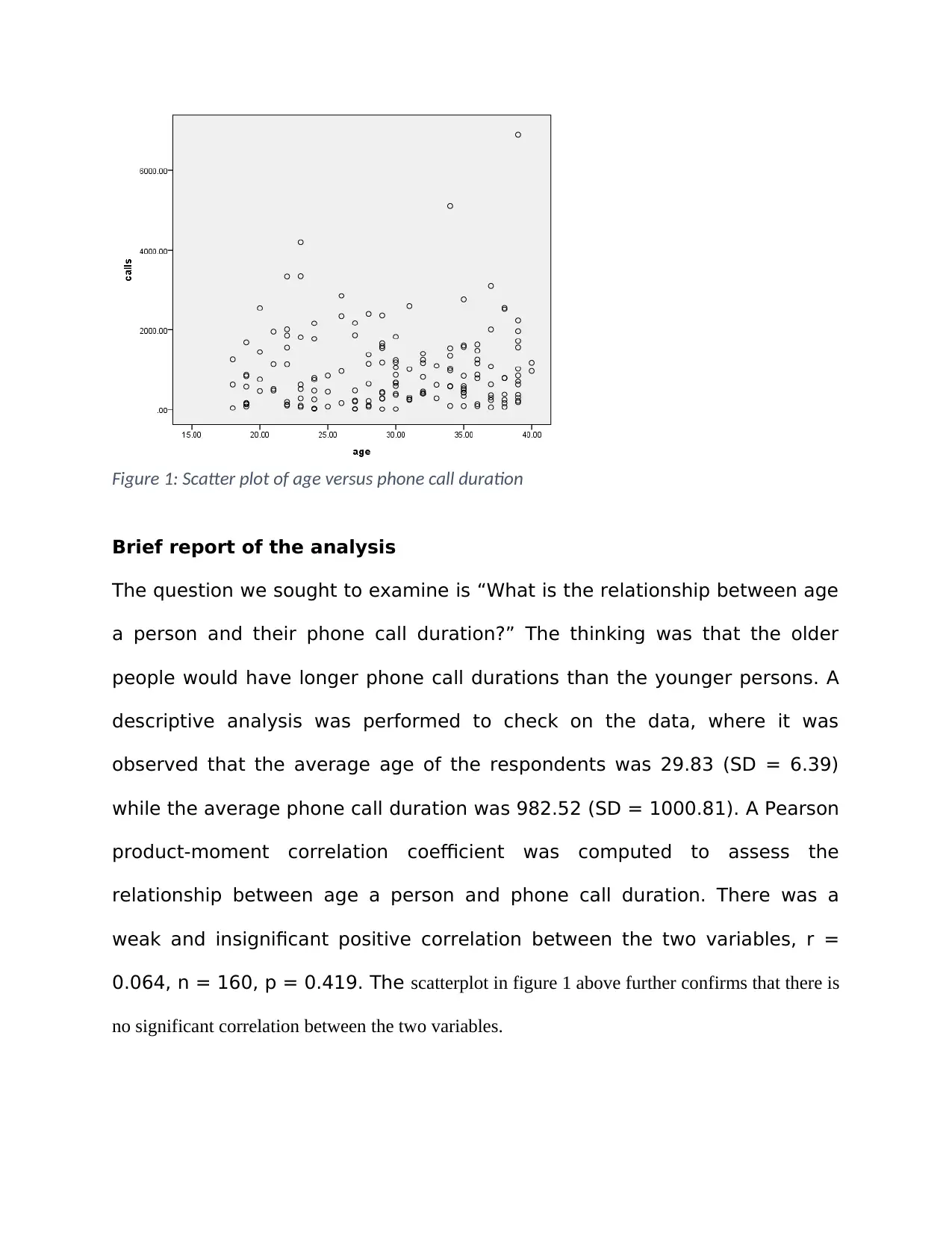
Figure 1: Scatter plot of age versus phone call duration
Brief report of the analysis
The question we sought to examine is “What is the relationship between age
a person and their phone call duration?” The thinking was that the older
people would have longer phone call durations than the younger persons. A
descriptive analysis was performed to check on the data, where it was
observed that the average age of the respondents was 29.83 (SD = 6.39)
while the average phone call duration was 982.52 (SD = 1000.81). A Pearson
product-moment correlation coefficient was computed to assess the
relationship between age a person and phone call duration. There was a
weak and insignificant positive correlation between the two variables, r =
0.064, n = 160, p = 0.419. The scatterplot in figure 1 above further confirms that there is
no significant correlation between the two variables.
Brief report of the analysis
The question we sought to examine is “What is the relationship between age
a person and their phone call duration?” The thinking was that the older
people would have longer phone call durations than the younger persons. A
descriptive analysis was performed to check on the data, where it was
observed that the average age of the respondents was 29.83 (SD = 6.39)
while the average phone call duration was 982.52 (SD = 1000.81). A Pearson
product-moment correlation coefficient was computed to assess the
relationship between age a person and phone call duration. There was a
weak and insignificant positive correlation between the two variables, r =
0.064, n = 160, p = 0.419. The scatterplot in figure 1 above further confirms that there is
no significant correlation between the two variables.
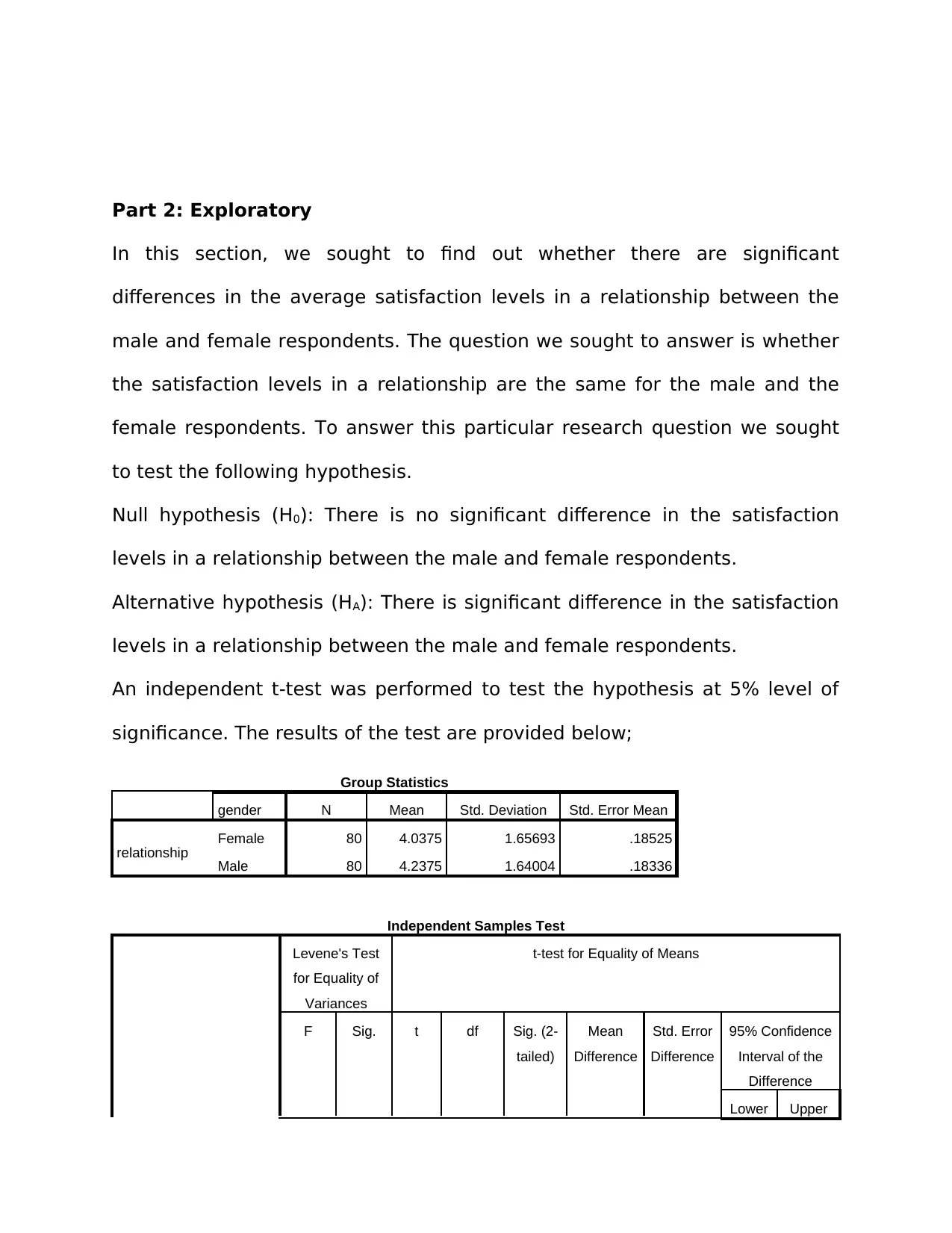
Part 2: Exploratory
In this section, we sought to find out whether there are significant
differences in the average satisfaction levels in a relationship between the
male and female respondents. The question we sought to answer is whether
the satisfaction levels in a relationship are the same for the male and the
female respondents. To answer this particular research question we sought
to test the following hypothesis.
Null hypothesis (H0): There is no significant difference in the satisfaction
levels in a relationship between the male and female respondents.
Alternative hypothesis (HA): There is significant difference in the satisfaction
levels in a relationship between the male and female respondents.
An independent t-test was performed to test the hypothesis at 5% level of
significance. The results of the test are provided below;
Group Statistics
gender N Mean Std. Deviation Std. Error Mean
relationship Female 80 4.0375 1.65693 .18525
Male 80 4.2375 1.64004 .18336
Independent Samples Test
Levene's Test
for Equality of
Variances
t-test for Equality of Means
F Sig. t df Sig. (2-
tailed)
Mean
Difference
Std. Error
Difference
95% Confidence
Interval of the
Difference
Lower Upper
In this section, we sought to find out whether there are significant
differences in the average satisfaction levels in a relationship between the
male and female respondents. The question we sought to answer is whether
the satisfaction levels in a relationship are the same for the male and the
female respondents. To answer this particular research question we sought
to test the following hypothesis.
Null hypothesis (H0): There is no significant difference in the satisfaction
levels in a relationship between the male and female respondents.
Alternative hypothesis (HA): There is significant difference in the satisfaction
levels in a relationship between the male and female respondents.
An independent t-test was performed to test the hypothesis at 5% level of
significance. The results of the test are provided below;
Group Statistics
gender N Mean Std. Deviation Std. Error Mean
relationship Female 80 4.0375 1.65693 .18525
Male 80 4.2375 1.64004 .18336
Independent Samples Test
Levene's Test
for Equality of
Variances
t-test for Equality of Means
F Sig. t df Sig. (2-
tailed)
Mean
Difference
Std. Error
Difference
95% Confidence
Interval of the
Difference
Lower Upper
Secure Best Marks with AI Grader
Need help grading? Try our AI Grader for instant feedback on your assignments.
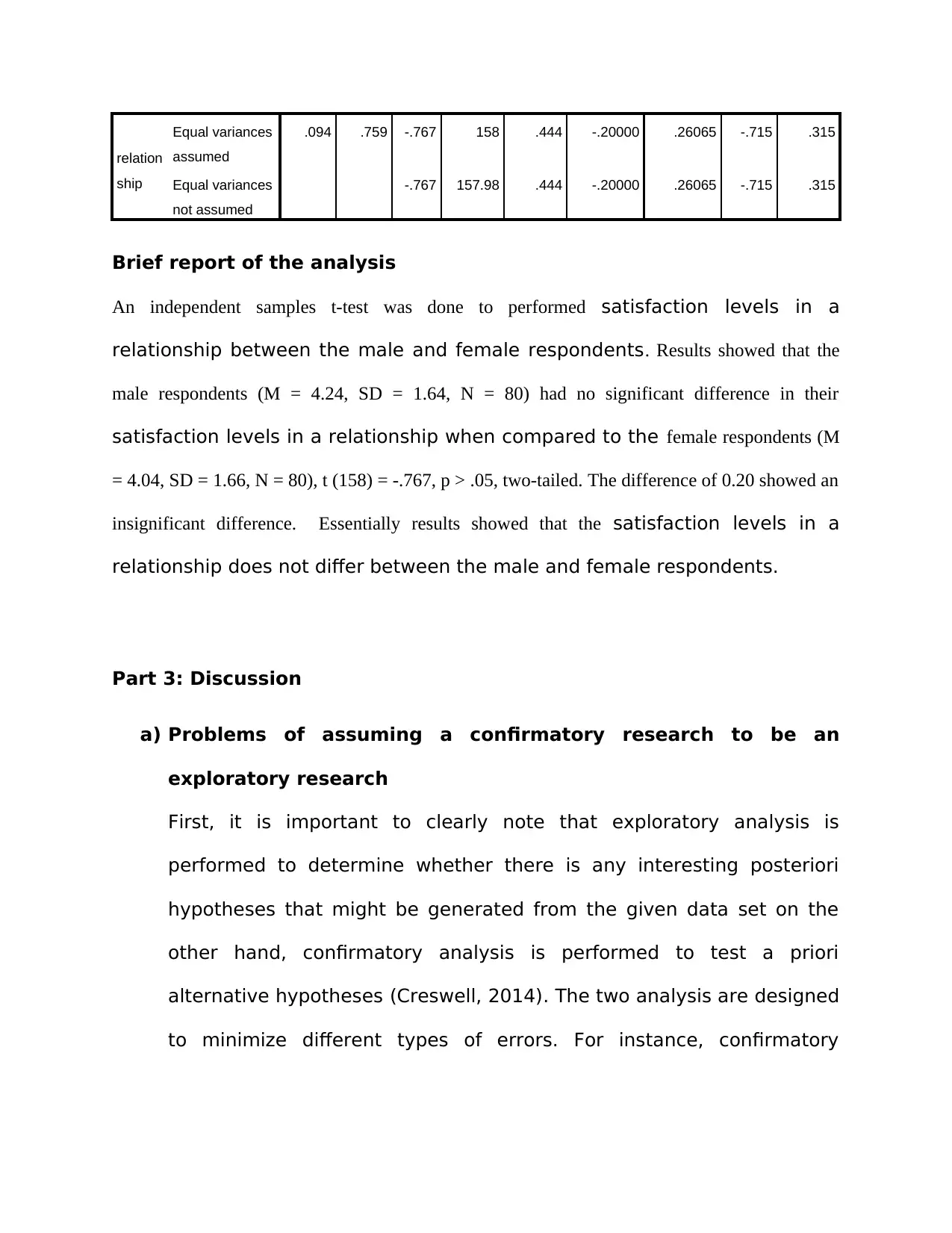
relation
ship
Equal variances
assumed
.094 .759 -.767 158 .444 -.20000 .26065 -.715 .315
Equal variances
not assumed
-.767 157.98 .444 -.20000 .26065 -.715 .315
Brief report of the analysis
An independent samples t-test was done to performed satisfaction levels in a
relationship between the male and female respondents. Results showed that the
male respondents (M = 4.24, SD = 1.64, N = 80) had no significant difference in their
satisfaction levels in a relationship when compared to the female respondents (M
= 4.04, SD = 1.66, N = 80), t (158) = -.767, p > .05, two-tailed. The difference of 0.20 showed an
insignificant difference. Essentially results showed that the satisfaction levels in a
relationship does not differ between the male and female respondents.
Part 3: Discussion
a) Problems of assuming a confirmatory research to be an
exploratory research
First, it is important to clearly note that exploratory analysis is
performed to determine whether there is any interesting posteriori
hypotheses that might be generated from the given data set on the
other hand, confirmatory analysis is performed to test a priori
alternative hypotheses (Creswell, 2014). The two analysis are designed
to minimize different types of errors. For instance, confirmatory
ship
Equal variances
assumed
.094 .759 -.767 158 .444 -.20000 .26065 -.715 .315
Equal variances
not assumed
-.767 157.98 .444 -.20000 .26065 -.715 .315
Brief report of the analysis
An independent samples t-test was done to performed satisfaction levels in a
relationship between the male and female respondents. Results showed that the
male respondents (M = 4.24, SD = 1.64, N = 80) had no significant difference in their
satisfaction levels in a relationship when compared to the female respondents (M
= 4.04, SD = 1.66, N = 80), t (158) = -.767, p > .05, two-tailed. The difference of 0.20 showed an
insignificant difference. Essentially results showed that the satisfaction levels in a
relationship does not differ between the male and female respondents.
Part 3: Discussion
a) Problems of assuming a confirmatory research to be an
exploratory research
First, it is important to clearly note that exploratory analysis is
performed to determine whether there is any interesting posteriori
hypotheses that might be generated from the given data set on the
other hand, confirmatory analysis is performed to test a priori
alternative hypotheses (Creswell, 2014). The two analysis are designed
to minimize different types of errors. For instance, confirmatory
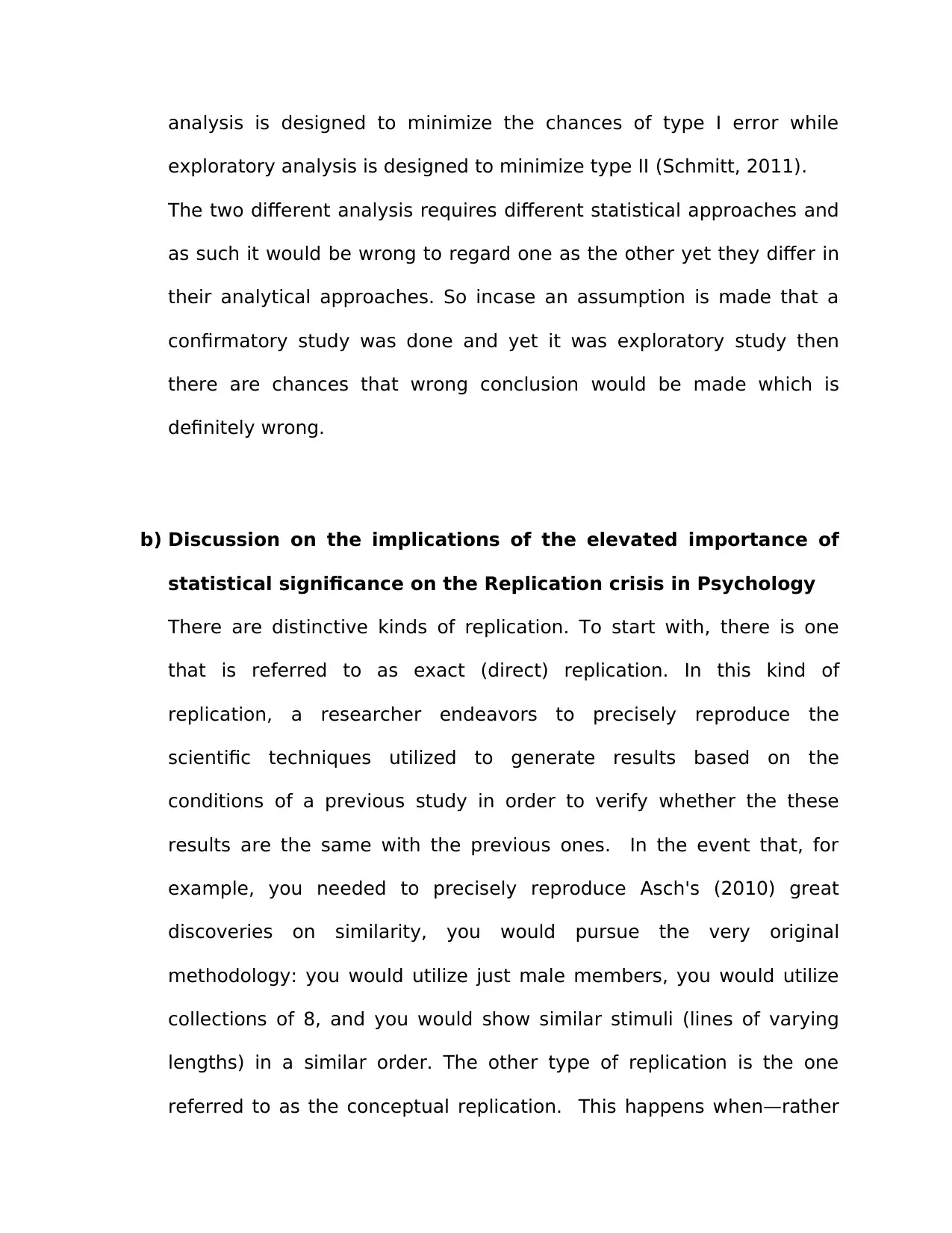
analysis is designed to minimize the chances of type I error while
exploratory analysis is designed to minimize type II (Schmitt, 2011).
The two different analysis requires different statistical approaches and
as such it would be wrong to regard one as the other yet they differ in
their analytical approaches. So incase an assumption is made that a
confirmatory study was done and yet it was exploratory study then
there are chances that wrong conclusion would be made which is
definitely wrong.
b) Discussion on the implications of the elevated importance of
statistical significance on the Replication crisis in Psychology
There are distinctive kinds of replication. To start with, there is one
that is referred to as exact (direct) replication. In this kind of
replication, a researcher endeavors to precisely reproduce the
scientific techniques utilized to generate results based on the
conditions of a previous study in order to verify whether the these
results are the same with the previous ones. In the event that, for
example, you needed to precisely reproduce Asch's (2010) great
discoveries on similarity, you would pursue the very original
methodology: you would utilize just male members, you would utilize
collections of 8, and you would show similar stimuli (lines of varying
lengths) in a similar order. The other type of replication is the one
referred to as the conceptual replication. This happens when—rather
exploratory analysis is designed to minimize type II (Schmitt, 2011).
The two different analysis requires different statistical approaches and
as such it would be wrong to regard one as the other yet they differ in
their analytical approaches. So incase an assumption is made that a
confirmatory study was done and yet it was exploratory study then
there are chances that wrong conclusion would be made which is
definitely wrong.
b) Discussion on the implications of the elevated importance of
statistical significance on the Replication crisis in Psychology
There are distinctive kinds of replication. To start with, there is one
that is referred to as exact (direct) replication. In this kind of
replication, a researcher endeavors to precisely reproduce the
scientific techniques utilized to generate results based on the
conditions of a previous study in order to verify whether the these
results are the same with the previous ones. In the event that, for
example, you needed to precisely reproduce Asch's (2010) great
discoveries on similarity, you would pursue the very original
methodology: you would utilize just male members, you would utilize
collections of 8, and you would show similar stimuli (lines of varying
lengths) in a similar order. The other type of replication is the one
referred to as the conceptual replication. This happens when—rather
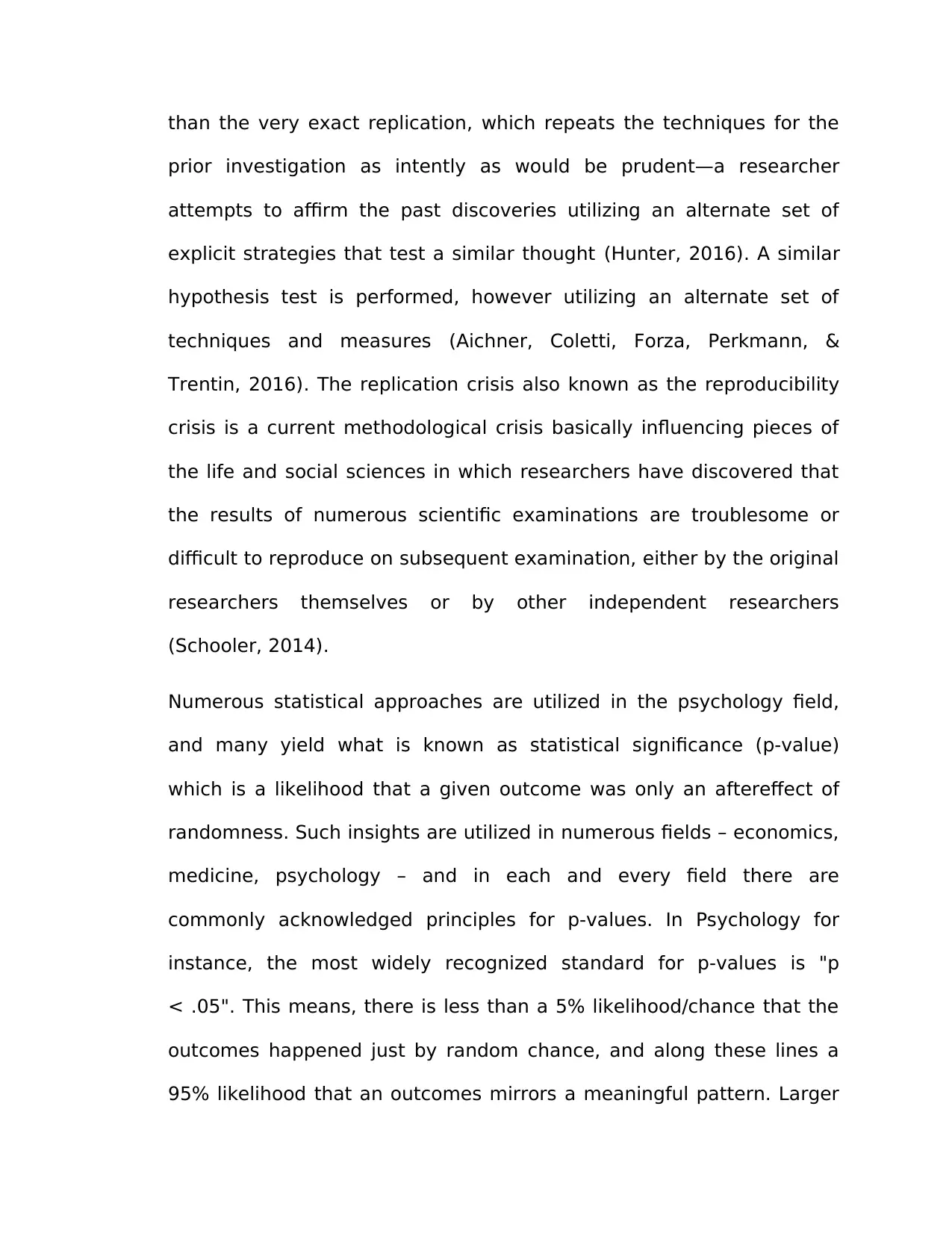
than the very exact replication, which repeats the techniques for the
prior investigation as intently as would be prudent—a researcher
attempts to affirm the past discoveries utilizing an alternate set of
explicit strategies that test a similar thought (Hunter, 2016). A similar
hypothesis test is performed, however utilizing an alternate set of
techniques and measures (Aichner, Coletti, Forza, Perkmann, &
Trentin, 2016). The replication crisis also known as the reproducibility
crisis is a current methodological crisis basically influencing pieces of
the life and social sciences in which researchers have discovered that
the results of numerous scientific examinations are troublesome or
difficult to reproduce on subsequent examination, either by the original
researchers themselves or by other independent researchers
(Schooler, 2014).
Numerous statistical approaches are utilized in the psychology field,
and many yield what is known as statistical significance (p-value)
which is a likelihood that a given outcome was only an aftereffect of
randomness. Such insights are utilized in numerous fields – economics,
medicine, psychology – and in each and every field there are
commonly acknowledged principles for p-values. In Psychology for
instance, the most widely recognized standard for p-values is "p
< .05". This means, there is less than a 5% likelihood/chance that the
outcomes happened just by random chance, and along these lines a
95% likelihood that an outcomes mirrors a meaningful pattern. Larger
prior investigation as intently as would be prudent—a researcher
attempts to affirm the past discoveries utilizing an alternate set of
explicit strategies that test a similar thought (Hunter, 2016). A similar
hypothesis test is performed, however utilizing an alternate set of
techniques and measures (Aichner, Coletti, Forza, Perkmann, &
Trentin, 2016). The replication crisis also known as the reproducibility
crisis is a current methodological crisis basically influencing pieces of
the life and social sciences in which researchers have discovered that
the results of numerous scientific examinations are troublesome or
difficult to reproduce on subsequent examination, either by the original
researchers themselves or by other independent researchers
(Schooler, 2014).
Numerous statistical approaches are utilized in the psychology field,
and many yield what is known as statistical significance (p-value)
which is a likelihood that a given outcome was only an aftereffect of
randomness. Such insights are utilized in numerous fields – economics,
medicine, psychology – and in each and every field there are
commonly acknowledged principles for p-values. In Psychology for
instance, the most widely recognized standard for p-values is "p
< .05". This means, there is less than a 5% likelihood/chance that the
outcomes happened just by random chance, and along these lines a
95% likelihood that an outcomes mirrors a meaningful pattern. Larger
Paraphrase This Document
Need a fresh take? Get an instant paraphrase of this document with our AI Paraphraser
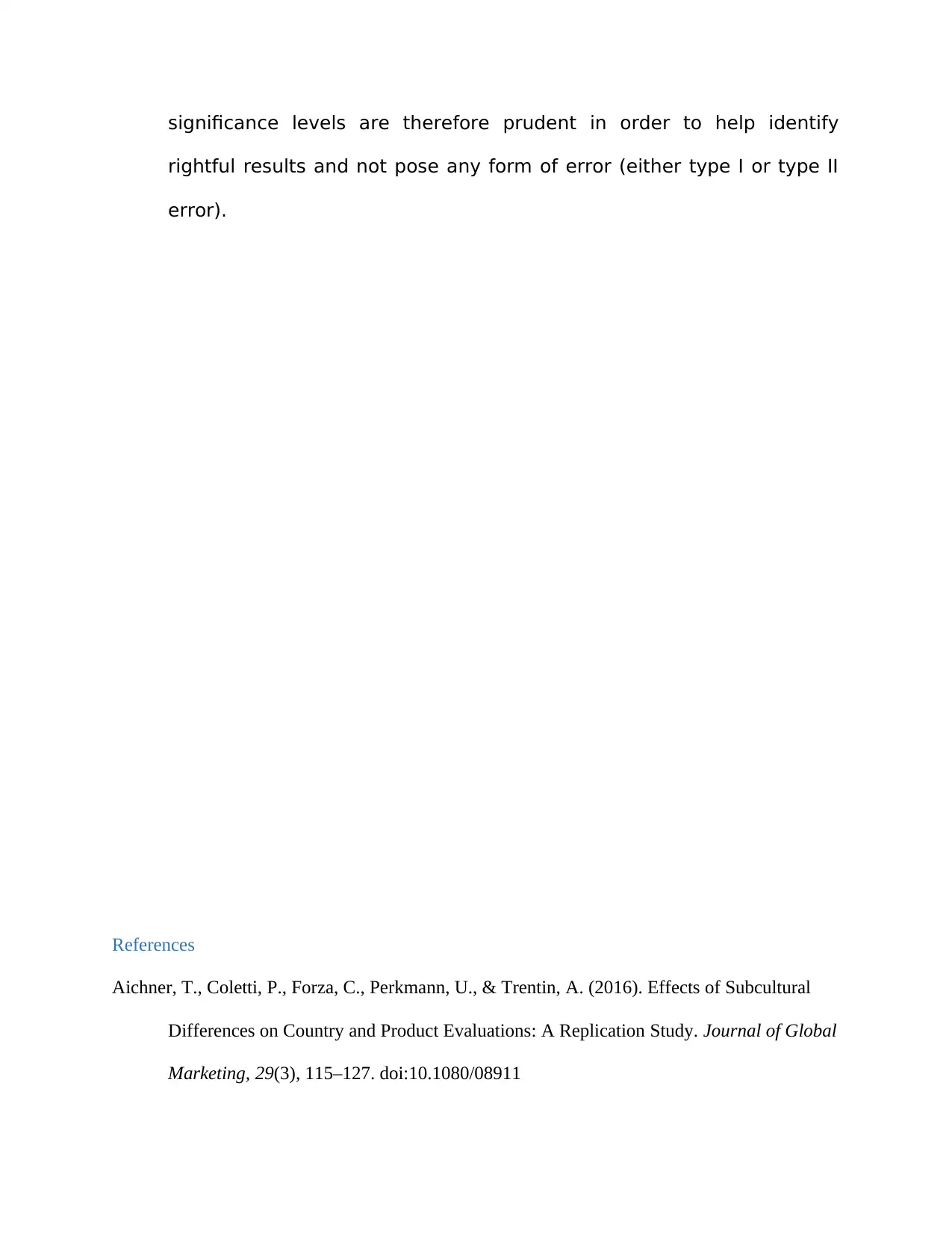
significance levels are therefore prudent in order to help identify
rightful results and not pose any form of error (either type I or type II
error).
References
Aichner, T., Coletti, P., Forza, C., Perkmann, U., & Trentin, A. (2016). Effects of Subcultural
Differences on Country and Product Evaluations: A Replication Study. Journal of Global
Marketing, 29(3), 115–127. doi:10.1080/08911
rightful results and not pose any form of error (either type I or type II
error).
References
Aichner, T., Coletti, P., Forza, C., Perkmann, U., & Trentin, A. (2016). Effects of Subcultural
Differences on Country and Product Evaluations: A Replication Study. Journal of Global
Marketing, 29(3), 115–127. doi:10.1080/08911
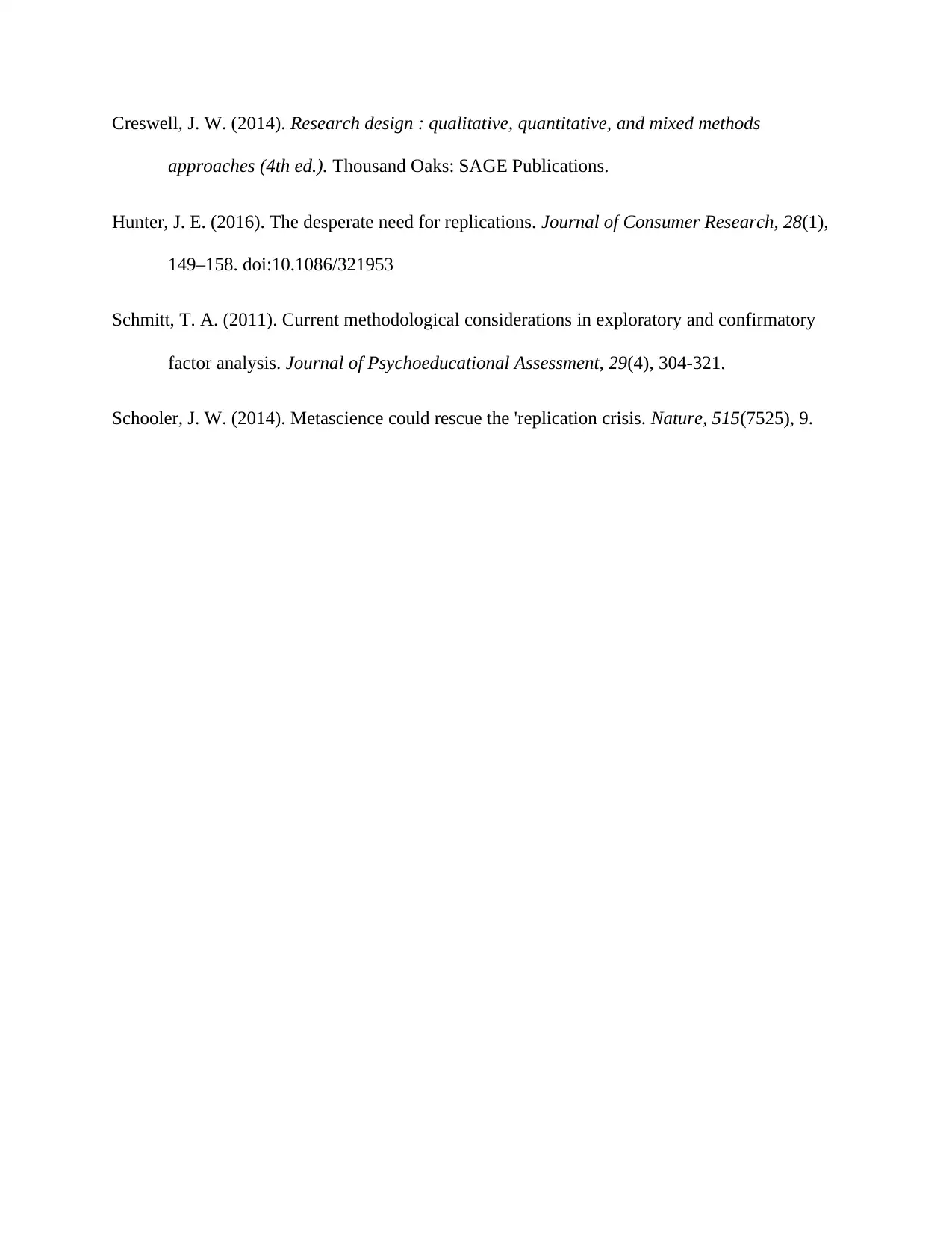
Creswell, J. W. (2014). Research design : qualitative, quantitative, and mixed methods
approaches (4th ed.). Thousand Oaks: SAGE Publications.
Hunter, J. E. (2016). The desperate need for replications. Journal of Consumer Research, 28(1),
149–158. doi:10.1086/321953
Schmitt, T. A. (2011). Current methodological considerations in exploratory and confirmatory
factor analysis. Journal of Psychoeducational Assessment, 29(4), 304-321.
Schooler, J. W. (2014). Metascience could rescue the 'replication crisis. Nature, 515(7525), 9.
approaches (4th ed.). Thousand Oaks: SAGE Publications.
Hunter, J. E. (2016). The desperate need for replications. Journal of Consumer Research, 28(1),
149–158. doi:10.1086/321953
Schmitt, T. A. (2011). Current methodological considerations in exploratory and confirmatory
factor analysis. Journal of Psychoeducational Assessment, 29(4), 304-321.
Schooler, J. W. (2014). Metascience could rescue the 'replication crisis. Nature, 515(7525), 9.
1 out of 9
Related Documents
Your All-in-One AI-Powered Toolkit for Academic Success.
+13062052269
info@desklib.com
Available 24*7 on WhatsApp / Email
![[object Object]](/_next/static/media/star-bottom.7253800d.svg)
Unlock your academic potential
© 2024 | Zucol Services PVT LTD | All rights reserved.





